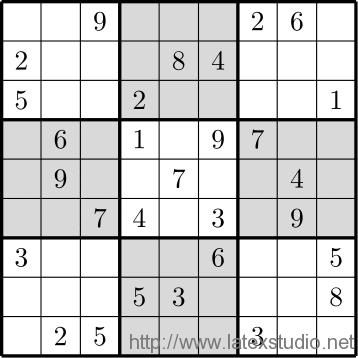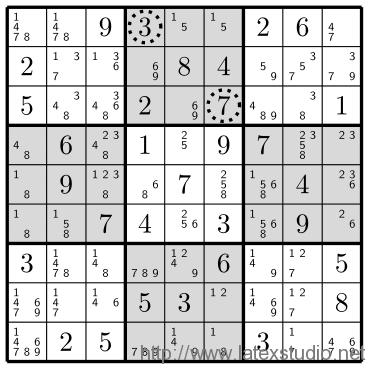\documentclass{standalone}
\usepackage{tikz}
\usetikzlibrary{backgrounds}
\usepackage{graphicx}
\pagenumbering{gobble}
% Some customizable styles
\tikzset {
highlight/.style = {gray, opacity=0.3},
digit/.style = {minimum height = 5mm, minimum width=5mm, anchor=center },
circle/.style = {draw=black!80!black, dotted, very thick},
cross/.style = {red, opacity=.5, shorten >=1mm, shorten <=1mm, very thick, line cap=round},
hint/.style={black, font=\sf, minimum width=3mm, minimum height=3mm}
}
% Original code-----------------------------------------------------------
% Modified the \node to give a unique name to each one, which is the
% row number, a dash and the column number. E.g: 1-1, 4-5, etc.
\newcounter{row}
\newcounter{col}
\newcommand\setrow[9]{
\setcounter{col}{1}
\foreach \n in {#1, #2, #3, #4, #5, #6, #7, #8, #9} {
\edef\x{\value{col} - 0.5}
\edef\y{9.5 - \value{row}}
\node[digit,name={\arabic{row}-\arabic{col}}] at (\x, \y) {\n};
\stepcounter{col}
}
\stepcounter{row}
}
% New code -------------------------------------------------------------
\def\highlightcell#1#2{
\fill[highlight] (#1-#2.north west) rectangle (#1-#2.south east);
}
\def\circlecell#1#2{
\draw[circle] (#1-#2) circle(4mm);
}
\def\crosscell#1#2{
\draw[cross] (#1-#2.north west) -- (#1-#2.south east);
\draw[cross] (#1-#2.north east) -- (#1-#2.south west);
}
\def\highlightrow#1{
\fill[highlight] (#1-1.north west) rectangle (#1-9.south east);
}
\def\highlighcolumn#1{
\fill[highlight] (1-#1.north west) rectangle (9-#1.south east);
}
\def\hintcell#1#2#3{
\node at (#1-#2) {\hintbox{#3}};
}
\def\highlightrectangle#1#2#3#4{
\begin{pgfonlayer}{background}
\fill[highlight] (#1-#2.north west) rectangle (#3-#4.south east);
\end{pgfonlayer}
}
% UGLY code. Do not read :-)
\def\hintbox#1{
\resizebox{4.5mm}{4.5mm}{%
\tikz[scale=0.3]{%
\def\auxc{0}
\foreach \m in {1,...,9} {
\pgfmathparse{mod(\auxc,3)}
\xdef\x{\pgfmathresult}
\pgfmathparse{-floor(\auxc/3)}
\xdef\y{\pgfmathresult}
\xdef\hintprinted{0}
\foreach \n in {#1} {
\ifnum\n=\m
\node[hint] at (\x,\y) {\n};
\xdef\hintprinted{1}
\fi
}
\ifnum\hintprinted=0
\node[hint, opacity=0] at (\x,\y) {\m};
\fi
\pgfmathparse{\auxc+1}
\xdef\auxc{\pgfmathresult}
}
}%
}
}
\begin{document}
\begin{tikzpicture}[scale=.5]
\begin{scope}
\draw (0, 0) grid (9, 9);
\draw[very thick, scale=3] (0, 0) grid (3, 3);
\setcounter{row}{1}
% Single entries
\setrow { }{ }{9} { }{ }{ } {2}{6}{ }
\setrow {2}{ }{ } { }{8}{4} { }{ }{ }
\setrow {5}{ }{ } {2}{ }{ } { }{ }{1}
\setrow { }{6}{ } {1}{ }{9} {7}{ }{ }
\setrow { }{9}{ } { }{7}{ } { }{4}{ }
\setrow { }{ }{7} {4}{ }{3} { }{9}{ }
\setrow {3}{ }{ } { }{ }{6} { }{ }{5}
\setrow { }{ }{ } {5}{3}{ } { }{ }{8}
\setrow { }{2}{5} { }{ }{ } {3}{ }{ }
\highlightrectangle{1}{4}{3}{6}
\highlightrectangle{4}{1}{6}{3}
\highlightrectangle{4}{7}{6}{9}
\highlightrectangle{7}{4}{9}{6}
\end{scope}
\end{tikzpicture}
\end{document}代码摘自一个关于数独的报告,https://github.com/ithanium/sudoku_report。
当然还有一个宏包也可以绘制数独游戏的,http://www.ctan.org/pkg/sudoku,这一个宏包的输入比较可视化、直观,不过要花点时间填写内容。有这类兴趣的用户可以自己测试下。
下载区
本站下载:sudoku_report-master






发表评论 取消回复